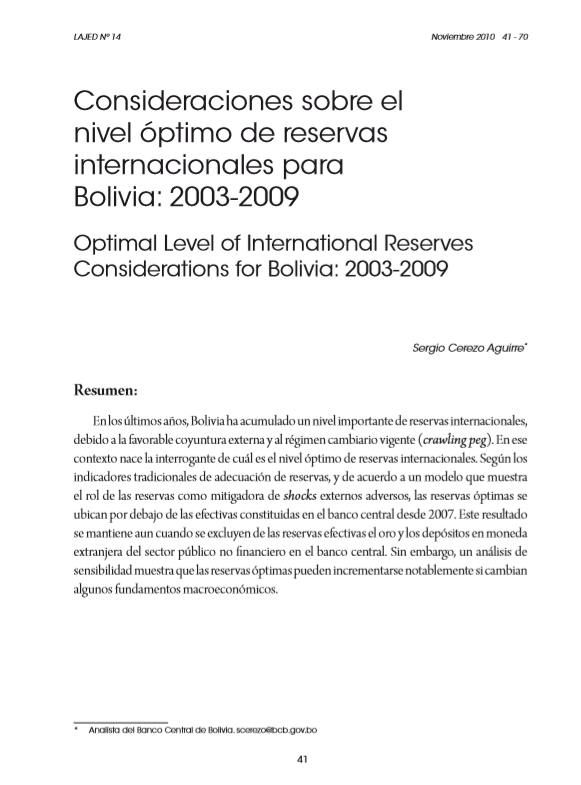Optimal Level of International Reserves Considerations for Bolivia: 2003-2009
DOI:
https://doi.org/10.35319/lajed.201014356Keywords:
International reserves, balance of payments crisis, dollarizationAbstract
In recent years, Bolivia has accumulated a significant level of international reserves due to favorable external environment and the exchange rate regimen (crawling peg). In this context arises the question of: Which one is the optimal level of international reserves? According to the traditional indicators of adequacy of reserves and according to a model that shows the role of the reserves as a reliever of adverse external shocks, optimal reserves are located below the actual saved in the central bank since 2007. This result holds even when gold and non-financial public sector deposits of foreign currency at the central bank are excluded from the actual reserves. However, a sensitivity analysis shows that optimal reserves may increase considerably if some macroeconomic fundamentals change.
Downloads
References
Bussiere, M. y C. Mulder. 1999. “External Vulnerability in Emerging Market Economies - How High Liquidity Can Offset Weak Fundamentals and the Effects of Contagion”. IMF Working Papers 99/88, (Washington: International Monetary Fund).
Dehesa, M., E. Pineda y W. Samuel. 2009. “Optimal Reserves in the Eastern Caribbean Currency Union”. IMF Working Paper No. 09/77 (Washington: International Monetary Fund).
FMI. 2007. “Perspectivas económicas: las Américas”. Estudios económicos y financieros, Noviembre.
García, P. y C. Soto. 2006. “Large Hoardings of International Reserves: Are They Worth It?”. En: Ricardo Caballero, César Calderón y Luis Felipe Céspedes (eds): External Vulnerability and Preventive Policies. Santiago, Chile: Banco Central de Chile.
Gonçalves, F. 2007. “The Optimal Level of Foreign Reserves in Financially Dollarized
Gonçalves, F. 2007. “The Optimal Level of Foreign Reserves in Financially Dollarized Economies: The Case of Uruguay”. IMF Working Paper No. 07/265 (Washington: International Monetary Fund).
Green, R. y T. Torgerson. 2007. “Are High Foreign Exchange Reserves in Emerging Markets a Blessing or a Burden?”. Department of the Treasury, Office of International Affairs, Occasional Paper No. 6.
Hauner, D. 2005. “A Fiscal Tag for International Reserves”. IMF Working Paper No. 05/81 (Washington: International Monetary Fund).
Holger Floerkemeier, H. y M. Sumlinski. 2008. “International Reserve Trends in the South Caucasus and Central Asia Region”. IMF Working Paper No. 08/41 (Washington: International Monetary Fund).
Hutchison, M. e I. Noy. 2006. “Sudden stops and the Mexican wave: Currency crises, capital flow reversals and output loss in emerging markets”. Journal of Development Economics, Elsevier, vol. 79(1), pages 225-248, February.
Jeanne, O. 2007. “International Reserves in Emerging Market Countries: Too Much of a Good Thing?”. Brooking Papers on Economic Activity, 1:2007.
Jeanne, O. y R. Rancière. 2006. “The Optimal Level of International Reserves for Emerging Market Countries: Formulas and Applications”. IMF Working Paper No. 06/229 (Washington: International Monetary Fund).
Lahura E. y D. Rodriguez. 2007. “Nivel óptimo de reservas internacionales en el Perú”. Mimeo.
Levy Yeyati, E. 2006. “Liquidity Insurance in a Financially Dollarized Economy”. NBER Working Papers 12345, National Bureau of Economic Research, Inc.
Rodríguez, H. 2007. “Proyecto de investigación conjunta sobre variables no observables: producto potencial”. Banco Central de Bolivia.
Ruiz-Arranz, M. y M. Zavadjil. 2008. “Are Emerging Asia’s Reserves Really Too High?” IMF Working Paper No. 08/192 (Washington: International Monetary Fund).
Sumlinski, M. 2008. “International Reserves - Too Much of a Zipf ’s Thing”. IMF Working Paper No. 08/11 (Washington: International Monetary Fund).






